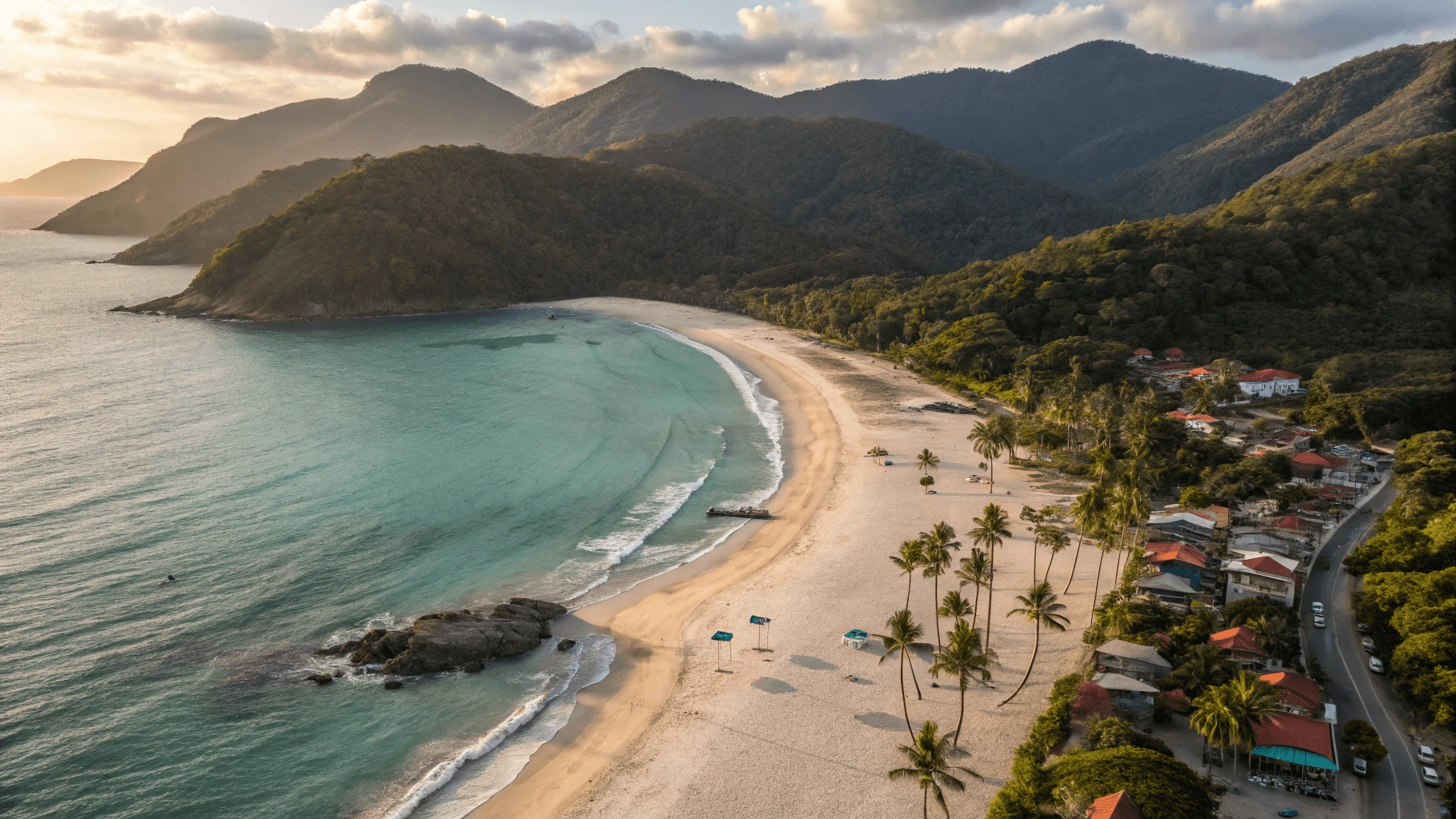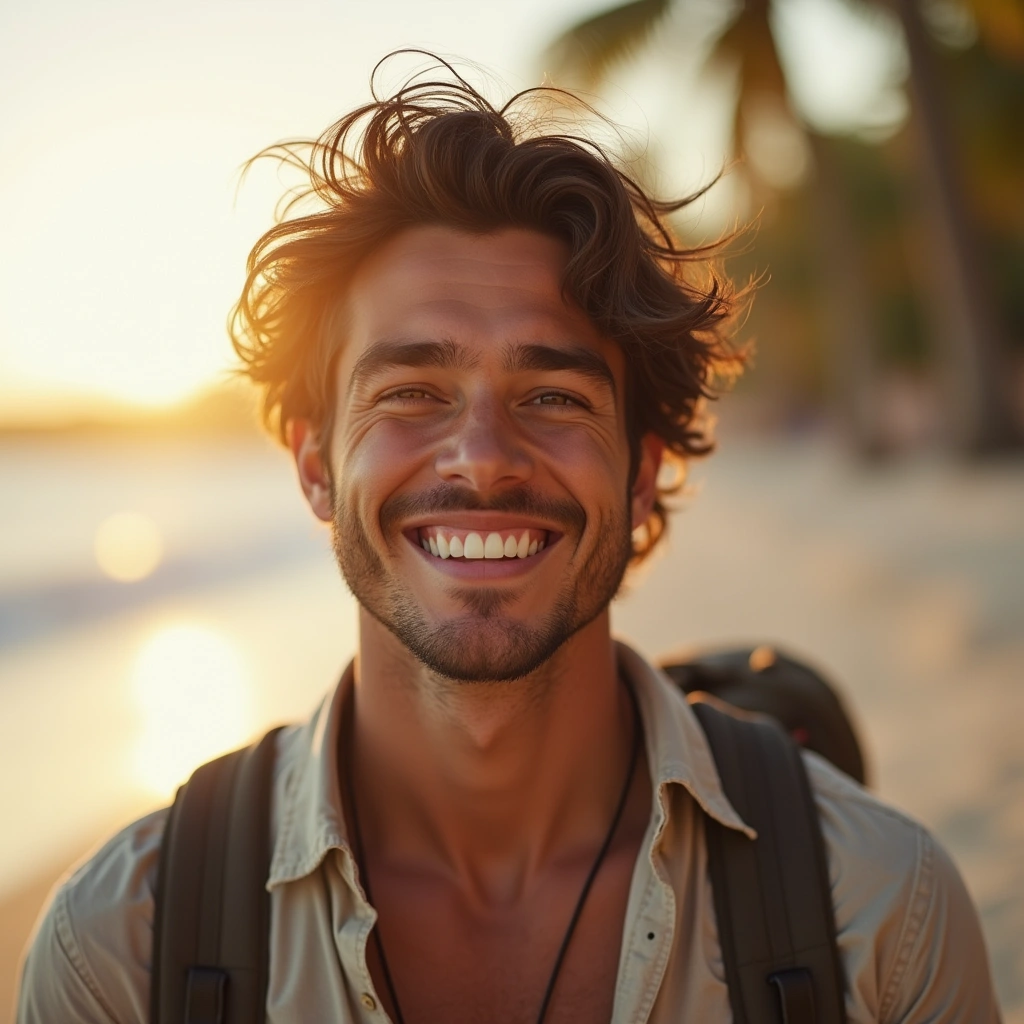Introduction
Brazil’s coastline stretches over 7,000 kilometers, creating a paradise for beach lovers with landscapes that range from bustling urban shores to untouched tropical havens. Whether you’re seeking the rhythmic energy of Rio’s famous beaches, the pristine white sands of the Northeast, or the secluded coves of the South, Brazil offers an unparalleled beach experience for every traveler.
This guide takes you on a journey through Brazil’s most spectacular beaches in brazil, providing essential information on what makes each unique, who will love them most, and how to experience them to their fullest. From world-famous stretches of sand to hidden gems that locals treasure, we’ve assembled the most comprehensive resource available for exploring Brazil’s coastal wonders.
With its perfect combination of natural beauty, vibrant culture, and tropical climate, Brazil stands as one of the world’s premier beach destinations. Let’s explore the sandy shores that have captivated travelers for generations and discover why Brazilian beaches in brazil deserve a top spot on your travel bucket list.
Table of Contents
Best Overall Beaches in Brazil

Copacabana Beach (Rio de Janeiro)
Why it’s famous: Perhaps Brazil’s most iconic beach, Copacabana’s 4 km crescent of sand sits beneath the watchful gaze of Sugarloaf Mountain. Its distinctive black and white mosaic promenade (the famous Avenida Atlântica) is a cultural landmark in itself.
Who it’s best for: People-watchers, social butterflies, and those who want to experience the quintessential Rio beach scene. The lively atmosphere makes it perfect for travelers seeking both relaxation and excitement.
Key Amenities:
- Numerous kiosks selling drinks and snacks
- Public showers and restrooms
- Beach chair and umbrella rentals
- Regular lifeguard presence
- Volleyball courts and exercise equipment
- Vibrant nightlife along the promenade
Getting There: Easily accessible by metro (Siqueira Campos or Cardeal Arcoverde stations) or by taxi from anywhere in Rio.
Ipanema Beach (Rio de Janeiro)
Why it’s famous: Immortalized in the bossa nova song “The Girl from Ipanema,” this trendy beach offers stunning views of the Dois Irmãos (Two Brothers) mountains. Each section of Ipanema has its own distinct crowd and vibe.
Who it’s best for: Fashion-conscious travelers, young professionals, and LGBTQ+ visitors (particularly near Posto 9). Ipanema offers a more sophisticated atmosphere than Copacabana.
Key Amenities:
- High-end beach vendors and kiosks
- Excellent restaurants and cafes nearby
- Beach chair and umbrella rentals
- Regular lifeguard patrol
- Sunday hippie fair (Feira Hippie) near Praça General Osório
- Consistently clean waters
Getting There: Take the metro to General Osório station, or a short taxi ride from other Rio neighborhoods.
Praia do Forte (Bahia)
Why it’s famous: This beach combines pristine natural beauty with ecological significance as a major sea turtle nesting site. The Tamar Project’s visitor center makes it educational as well as beautiful.
Who it’s best for: Nature lovers, families, and those seeking more peaceful beach time outside the major cities. The natural pools that form at low tide are perfect for children.
Key Amenities:
- The Tamar Project sea turtle conservation center
- Natural pools at low tide
- Good selection of restaurants and pousadas
- Clean facilities
- Handicraft shops
- Boat trips to nearby coral reefs
Getting There: Fly to Salvador, then take a 1-hour bus or drive north along the Coconut Highway (Estrada do Coco).
Lopes Mendes (Ilha Grande, Rio de Janeiro State)
Why it’s famous: Often rated among the world’s most beautiful beaches in brazil, Lopes Mendes offers 3 km of powdery white sand and crystal-clear waters, all within a protected ecological reserve.
Who it’s best for: Nature enthusiasts, photographers, and those seeking an unspoiled beach experience. The lack of development makes it ideal for purists.
Key Amenities:
- Minimal facilities (part of its charm)
- Few vendors selling basic refreshments
- Surf-worthy waves
- Pristine natural setting
- Some shade from trees at the beach edges
Getting There: Take a boat from Angra dos Reis to Vila do Abraão on Ilha Grande, then either hike 2 hours or take a taxi boat to a nearby beach followed by a short trail walk.
Praia do Sancho (Fernando de Noronha)
Why it’s famous: Frequently named the best beach in Brazil (and sometimes the world), this secluded bay features dramatic cliffs, turquoise waters, and abundant marine life. Access via a ladder through a rock crevice adds to its mystique.
Who it’s best for: Adventurous travelers, snorkelers, and those seeking breathtaking natural beauty. The effort required to reach it keeps crowds smaller.
Key Amenities:
- Exceptional snorkeling opportunities
- Limited facilities (bring water and snacks)
- Shaded areas under the cliff faces
- Consistently warm, clear water
- National park guides available
Getting There: Fly to Fernando de Noronha, then take a taxi to the trailhead, followed by a descent via ladder through a cliff crevice (not recommended for those with mobility issues).
Jericoacoara (Ceará)
Why it’s famous: This former fishing village turned bohemian beach paradise sits within a national park, offering massive sand dunes, steady winds for kitesurfing, and the famous Duna do Pôr do Sol (Sunset Dune).
Who it’s best for: Kitesurfers, windsurfers, bohemian travelers, and those seeking both adventure and relaxation. The village atmosphere and activities make it great for longer stays.
Key Amenities:
- Kite and windsurf schools and rentals
- Dune buggy tours
- Restaurants and beach bars
- Accommodation ranging from basic to luxury
- Hammocks over water at low tide
- No streetlights (stargazing paradise)
Getting There: Fly to Fortaleza or Jericoacoara Airport, then take a 4×4 vehicle through the national park (the final stretch requires off-road capability).
Praia do Espelho (Bahia)
Why it’s famous: The “Mirror Beach” earns its name from the reflective natural pools that form at low tide. This hidden gem in southern Bahia offers a peaceful alternative to the region’s more developed beaches in brazil.
Who it’s best for: Couples seeking romance, photography enthusiasts, and travelers looking for authentic coastal Brazil without large crowds.
Key Amenities:
- Several excellent seafood restaurants
- Natural tidal pools
- Some boutique accommodations nearby
- Local fishermen offering boat tours
- Minimal but sufficient facilities
Getting There: Drive approximately 1 hour south from Arraial d’Ajuda or Trancoso on partially unpaved roads.
Praia do Campeche (Florianópolis, Santa Catarina)
Why it’s famous: This 4 km stretch of sand offers the perfect balance of natural beauty and accessibility, with views of Campeche Island offshore and mountains inland.
Who it’s best for: Surfers of all levels, families, and those who appreciate a less crowded alternative to Florianópolis’s more famous beaches in brazil.
Key Amenities:
- Consistent waves for surfing
- Surf schools and board rentals
- Beachfront restaurants and kiosks
- Boat trips to Campeche Island
- Clean facilities
- Reasonable parking options
Getting There: A 30-minute drive from downtown Florianópolis.
Praia de Pipa (Rio Grande do Norte)
Why it’s famous: This stunning beach is known for its dramatic red cliffs, dolphin sightings, and bohemian village atmosphere. The area combines natural beauty with excellent infrastructure.
Who it’s best for: Dolphin watchers, surfers, and international travelers seeking a beach with both natural wonders and nightlife options.
Key Amenities:
- Dolphin-watching boat tours
- Surf schools and board rentals
- Numerous restaurants and bars
- Boutique shopping
- Accommodation for all budgets
- Ecological tours
Getting There: Fly to Natal, then drive approximately 80 km south (about 1.5 hours).
Porto de Galinhas (Pernambuco)
Why it’s famous: Known for its natural tide pools filled with colorful fish, crystal-clear waters, and palm-fringed shoreline. The name means “Port of Chickens,” dating back to the colonial era.
Who it’s best for: Families, snorkelers, and those seeking a beach with excellent infrastructure but maintained natural beauty.
Key Amenities:
- Natural reef pools perfect for snorkeling
- Jangada (traditional raft) rides over the reefs
- Full range of restaurants and accommodation
- Beach chair and umbrella rentals
- Diving centers
- Handicraft market
Getting There: Fly to Recife, then drive approximately 60 km south (about 1 hour).
Praia do Forno (Arraial do Cabo, Rio de Janeiro State)
Why it’s famous: Often called the “Brazilian Caribbean,” this small cove features incredibly clear blue waters contrasting with the surrounding red cliffs and verdant vegetation.
Who it’s best for: Snorkelers, photographers, and those seeking crystal-clear waters without traveling to the Northeast.
Key Amenities:
- Excellent snorkeling opportunities
- Some kiosks selling refreshments
- Shade from surrounding cliffs
- Boat tours of the region
- Trail access (moderate difficulty)
Getting There: Reach Arraial do Cabo (2.5 hours from Rio), then either hike a trail from town or take a short boat ride.
Baía do Sancho (Fernando de Noronha)
Why it’s famous: Another Fernando de Noronha gem, this bay features dramatic cliff views, abundant marine life, and what many consider the clearest waters in Brazil.
Who it’s best for: Wildlife enthusiasts, snorkelers, and those seeking seclusion and natural beauty.
Key Amenities:
- Prime snorkeling and diving
- Wildlife observation (including spinner dolphins)
- Limited facilities (bring necessities)
- Park rangers for information
- Magnificent photography opportunities
Getting There: Similar to Praia do Sancho, requiring a flight to Fernando de Noronha followed by a taxi and cliff descent.
Praia do Gunga (Alagoas)
Why it’s famous: This spectacular beach features coconut palm forests, emerald waters, and impressive sandstone cliffs. The combination of beach and lagoon creates diverse experiences.
Who it’s best for: Families, photography enthusiasts, and those seeking variety in their beach experience.
Key Amenities:
- Beach kiosks and restaurants
- Chair and umbrella rentals
- Jangada rides
- Coconut water vendors
- Lagoon for calm swimming
- Beach buggy rides
Getting There: Fly to Maceió, then drive approximately 30 km south (about 40 minutes).
Taipus de Fora (Península de Maraú, Bahia)
Why it’s famous: The extensive natural reef pools make this beach exceptional for snorkeling, with abundant marine life visible in shallow, warm waters.
Who it’s best for: Snorkelers, nature lovers, and those seeking a less-visited alternative to Morro de São Paulo.
Key Amenities:
- Expansive natural reef pools at low tide
- Beachfront pousadas and restaurants
- Snorkel equipment rentals
- Boat tours
- Nearby Península de Maraú attractions
- Stunning sunset views
Getting There: Fly to Ilhéus, then drive approximately 2 hours and take a ferry crossing.
Praia da Ilha do Mel (Paraná)
Why it’s famous: This car-free island offers pristine beaches in brazil, ecological reserves, and a laid-back atmosphere rarely found so close to major cities.
Who it’s best for: Eco-tourists, hikers, and those seeking a more alternative beach experience away from luxury resorts.
Key Amenities:
- No cars (pedestrian paths only)
- Ecological reserve areas
- Simple but charming pousadas
- Several beaches in brazil in one location
- Lighthouse with panoramic views
- Historic fort ruins
Getting There: Reach Pontal do Sul from Curitiba, then take a ferry to the island (approximately 30 minutes).
Lagoinha do Leste (Florianópolis, Santa Catarina)
Why it’s famous: One of Florianópolis’s most pristine beaches in brazil, accessible only by trail or boat, featuring a freshwater lagoon beside the ocean.
Who it’s best for: Hikers, adventure seekers, and those wanting to escape crowds for a more natural beach experience.
Key Amenities:
- Very minimal facilities (bring supplies)
- Freshwater lagoon for swimming
- Camping permitted
- Untouched natural beauty
- Excellent hiking opportunities
- Unique geography with lagoon meeting ocean
Getting There: Hike approximately 2 hours from Pantano do Sul or take a boat tour from Armação or Pântano do Sul.
Praia dos Carneiros (Pernambuco)
Why it’s famous: The iconic image of a small chapel perched at the end of a sandy peninsula, surrounded by coconut palms and calm waters, makes this beach instantly recognizable.
Who it’s best for: Families, photographers, and those seeking calm waters and shade.
Key Amenities:
- Natural pools at low tide
- São Benedito Chapel (a popular wedding venue)
- Beachfront restaurants
- Chair and umbrella rentals
- Boat tours
- Relatively calm waters
Getting There: Fly to Recife, then drive approximately 90 km south (about 1.5 hours).
Regional Deep Dives
Northeast beaches in brazil

The Northeast region boasts Brazil’s warmest waters, whitest sands, and most consistent sunshine. This tropical paradise stretches from Bahia to Maranhão, featuring coconut palm-lined shores and crystal-clear waters.
Regional Characteristics:
- Year-round warm temperatures
- Consistent sunshine (over 300 sunny days annually in many areas)
- Coconut palm-lined shores
- Coral reefs and natural pools
- Strong Portuguese colonial influences
- Rich Afro-Brazilian culture
- Vibrant local cuisine featuring fresh seafood
Key beaches in brazil of the Northeast
Praia de Patacho (Alagoas) This hidden treasure features powdery white sand, calm turquoise waters, and natural pools filled with marine life. Despite growing recognition, it remains peaceful and underdeveloped.
Praia de Maracajaú (Rio Grande do Norte) Known as “Brazil’s Caribbean,” this beach offers access to the “Parrachos” coral reef formation, creating perfect natural aquariums accessible by boat.
Praia dos Carneiros (Pernambuco) Beyond the iconic chapel, this beach offers kilometers of palm-fringed coastline and calm waters perfect for families.
Praia de Maragogi (Alagoas) Often compared to the Caribbean, Maragogi’s natural pools allow visitors to swim among tropical fish just offshore.
Praia do Futuro (Fortaleza, Ceará) This urban beach stretches for 8 km and is famous for its “barracas” (beach clubs) offering excellent seafood and infrastructure.
Praia da Pipa (Rio Grande do Norte) The combination of dramatic cliffs, regular dolphin sightings, and international atmosphere makes this a northeastern highlight.
Praia do Preá (Ceará) Near Jericoacoara, this beach has become world-renowned for kitesurfing due to its consistent winds and extended shallow areas.
Praia de Maracaípe (Pernambuco) Just beyond Porto de Galinhas, this beach is known for excellent surfing and the seahorse sanctuary in its mangroves.
Praia do Francês (Alagoas) This beach offers a unique combination of strong waves on one side and calm natural pools on the other, appealing to different types of beachgoers.
Praia do Saco (Sergipe) One of Brazil’s least-known coastal treasures, featuring pristine white dunes and a river meeting the ocean.
Southeast beaches in brazil
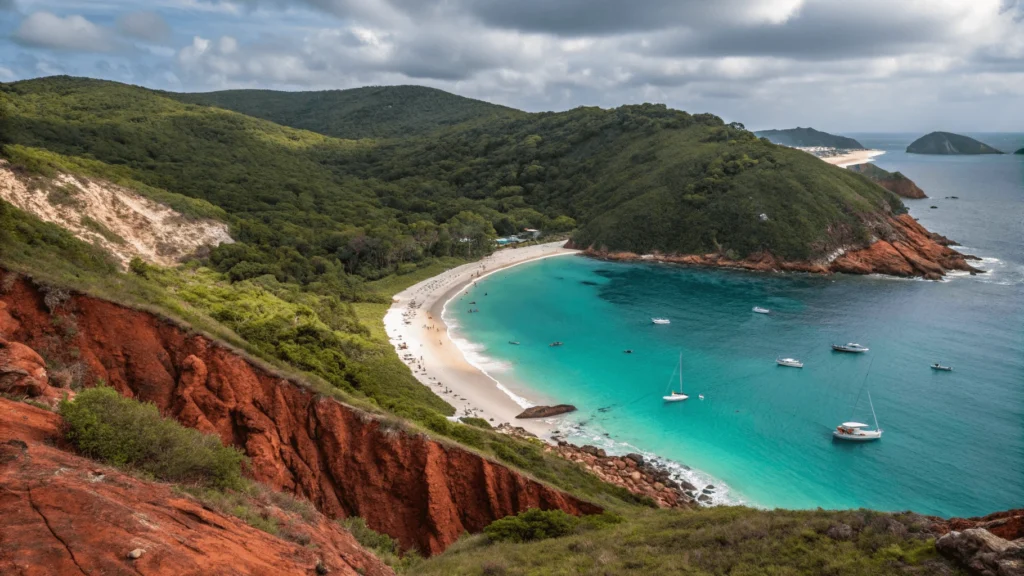
The Southeast region includes the coastlines of Espírito Santo, Rio de Janeiro, and São Paulo states, offering everything from world-famous urban beaches in brazil to secluded island hideaways.
Regional Characteristics:
- Mix of urban and wild beaches in brazil
- Mountainous backdrops in many areas
- Stronger waves (popular for surfing)
- More developed infrastructure
- Easier accessibility from major cities
- Greater seasonal variation (best from November to March)
- Historic coastal towns and forts
Key beaches in brazil of the Southeast
Praia de Grumari (Rio de Janeiro) This preserved beach within city limits offers a natural setting with mountains meeting the sea, yet remains less crowded than Rio’s famous beaches in brazil.
Prainha (Rio de Janeiro) Popular with surfers, this crescent-shaped beach is surrounded by rainforest-covered mountains and has environmental protection status.
Praia do Bonete (Ilhabela, São Paulo) Accessible only by boat or a challenging 3-hour hike, this beach rewards visitors with pristine beauty and seclusion.
Trindade beaches in brazil (Paraty, Rio de Janeiro State) This collection of beaches in brazil near the historic town of Paraty offers natural beauty, including the famous natural pool “Caixa d’Aço.”
Praia de Itaúnas (Espírito Santo) Famous for its massive sand dunes that buried the original village, this beach is now known for forró dancing and ecological preservation.
Praia de Castelhanos (Ilhabela, São Paulo) Accessible only by 4×4 vehicles or boat, this wild beach offers excellent surfing and a glimpse of traditional caiçara culture.
Praia do Peró (Cabo Frio, Rio de Janeiro State) Holder of the “Bandeira Azul” (Blue Flag) certification for environmental quality, this beach combines excellent infrastructure with clean waters. This beach proudly holds the international Blue Flag certification for environmental quality, as listed at.
Praia Brava (Ubatuba, São Paulo) Living up to its name (“brave beach”), this spot offers excellent surfing conditions and a more wild, natural setting.
Praia de Itamambuca (Ubatuba, São Paulo) One of Brazil’s premier surfing destinations, hosting international competitions while maintaining its natural beauty.
Praia dos Padres (Guarapari, Espírito Santo) Known for its “healing” monazite sands with natural radiation believed by some to have therapeutic properties. “beaches in brazil”
South beaches in brazil

Brazil’s southernmost coastline offers a different beach experience, with more dramatic seasonal changes, cooler waters, and European influences in the coastal culture.
Regional Characteristics:
- Distinct seasons (summer high season from December to February)
- Cooler water temperatures
- European cultural influences
- Dramatic landscapes with large dunes in some areas
- Stronger winds and waves (excellent for water sports)
- Whale watching opportunities (winter months)
- More temperate vegetation
Key beaches in brazil of the South
Praia Rosa (Santa Catarina) This horseshoe-shaped bay offers excellent surfing, whale watching in season, and a bohemian atmosphere.
Praia da Joaquina (Florianópolis, Santa Catarina) Famous for its massive sand dunes and international surfing competitions, this beach balances natural beauty with good infrastructure.
Praia de Bombinhas (Santa Catarina) This beach town peninsula features numerous small beaches in brazil with calm, clear waters perfect for snorkeling and diving.
Praia do Guarita (Torres, Rio Grande do Sul) Unique in Brazil for its black volcanic rock formations jutting from the sand and sea, creating a dramatic landscape.
Praia da Barra da Lagoa (Florianópolis, Santa Catarina) A long stretch of sand connecting a lagoon to the ocean, offering both calm waters and surf breaks.
Praia Mole (Florianópolis, Santa Catarina) Popular with a younger crowd, this beach is known for its natural beauty, good surf, and lively atmosphere.
Praia Brava (Itajaí, Santa Catarina) This surf beach offers consistent waves and has developed significant infrastructure while maintaining environmental standards. “beaches in brazil”
Praia do Campeche (Florianópolis, Santa Catarina) Beyond the beach itself, the nearby Campeche Island offers a preserved ecosystem with archaeological sites and crystal waters.
Praia da Armação (Florianópolis, Santa Catarina) This historical beach was once the center of whale hunting operations but now offers a more peaceful environment and access to hiking trails.
Praia de Taquaras (Balneário Camboriú, Santa Catarina) A more secluded option near the highly developed Balneário Camboriú, offering natural beauty and calmer waters. “beaches in brazil”
beaches in brazil by Interest/Type
Best Surfing beaches in brazil

Brazil has emerged as a world-class surfing destination with consistent waves, international competitions, and beaches in brazil suitable for all skill levels.
Praia de Itamambuca (Ubatuba, São Paulo)
- Wave Type: Beach break with occasional barrels
- Best For: Intermediate to advanced surfers
- Season: Year-round, best March-November
- Notable: Hosts stages of the Brazilian Surfing Circuit
Praia da Joaquina (Florianópolis, Santa Catarina)
- Wave Type: Consistent beach break with occasional large swells
- Best For: All levels, different sections for different abilities
- Season: Year-round, best April-October
- Notable: Site of numerous international competitions
Praia de Maresias (São Sebastião, São Paulo)
- Wave Type: Powerful beach break with tubes
- Best For: Intermediate to advanced surfers
- Season: Year-round, best April-September
- Notable: Home beach of Brazilian surfing champion Gabriel Medina
Praia do Rosa (Santa Catarina)
- Wave Type: Point break and beach break options
- Best For: All levels
- Season: Year-round, best March-November
- Notable: Also famous for whale watching during winter months
Praia da Silveira (Santa Catarina)
- Wave Type: Powerful point break
- Best For: Experienced surfers
- Season: Best April-October
- Notable: One of Brazil’s most perfect left-hand point breaks
Praia de Saquarema (Rio de Janeiro State)
- Wave Type: Consistent beach break
- Best For: All levels, dedicated areas for beginners
- Season: Year-round, best May-September
- Notable: “Brazilian Pipeline,” hosts World Surf League events
Praia do Francês (Alagoas)
- Wave Type: Reef break on one side, calm waters on the other
- Best For: Intermediate surfers
- Season: Best November-March
- Notable: One of the few good surfing spots in Northeast Brazil
Praia da Barra da Tijuca (Rio de Janeiro)
- Wave Type: Beach break with multiple peaks
- Best For: All levels
- Season: Year-round, best May-October
- Notable: Rio’s longest beach offers consistent waves away from the crowds
Best Family-Friendly beaches in brazil

These beaches in brazil offer calm waters, good infrastructure, and activities suitable for all ages.
Porto de Galinhas (Pernambuco)
- Key Features: Natural pools with calm, shallow waters; excellent infrastructure
- Family Amenities: Numerous family-friendly resorts, restaurants with children’s menus, jangada rides to see marine life
- Safety: Regular lifeguard presence, designated swimming areas “beaches in brazil”
Praia do Forte (Bahia)
- Key Features: Turtle conservation project, natural pools at low tide
- Family Amenities: Interactive environmental education center, gentle waters in protected areas
- Safety: Well-monitored beach with clear signage
Canasvieiras (Florianópolis, Santa Catarina)
- Key Features: Calm, warm waters; extensive infrastructure
- Family Amenities: Shallow waters extend far from shore, family-oriented accommodations
- Safety: Minimal waves, regular lifeguard presence
Praia dos Carneiros (Pernambuco)
- Key Features: Calm waters, natural shade from coconut palms
- Family Amenities: Space for children to play safely, boat rides to nearby areas
- Safety: Protected bay with minimal currents
Praia Grande (Ubatuba, São Paulo)
- Key Features: Wide beach with space for games, calm waters in protected sections
- Family Amenities: Playgrounds nearby, accessible paths
- Safety: Designated swimming areas with lifeguards
Praia do Peró (Cabo Frio, Rio de Janeiro State)
- Key Features: Blue Flag certification for environmental quality and safety
- Family Amenities: Clear waters, gentle slope into the sea
- Safety: Water quality monitoring, accessible information
Praia de Ponta Verde (Maceió, Alagoas)
- Key Features: Urban beach with excellent infrastructure
- Family Amenities: Natural pools at low tide, nearby parks and attractions
- Safety: Well-lit, monitored areas “beaches in brazil”
Praia de Taperapuan (Porto Seguro, Bahia)
- Key Features: Lively atmosphere with activities for all ages
- Family Amenities: Beach sports, entertainment, shallow waters
- Safety: Organized beach services, clear swimming areas
Best beaches in brazil for Nightlife/Social Scene

Brazil’s beach culture doesn’t end at sunset—these beaches offer vibrant nightlife and social scenes.
Copacabana (Rio de Janeiro)
- Nightlife Type: Beachfront kiosks, nearby clubs and bars, street performances
- Notable Venues: Copacabana Palace bars, Fosfobox club
- Atmosphere: Diverse crowd, international visitors, all-night energy
Praia de Pipa (Rio Grande do Norte)
- Nightlife Type: Beach bars transforming into nightclubs, live music
- Notable Venues: Calangos, Tribus Bar
- Atmosphere: International, bohemian vibe, relaxed elegance
Praia de Jurerê Internacional (Florianópolis, Santa Catarina)
- Nightlife Type: Upscale beach clubs, fashionable parties
- Notable Venues: P12, Cafe de la Musique
- Atmosphere: Sophisticated, celebrity spotting, high-energy
Praia de Morro de São Paulo (Bahia)
- Nightlife Type: Beach parties, live music venues
- Notable Venues: Segunda Praia bars, Toca do Morcego
- Atmosphere: Island party vibe, multi-day celebrations
Praia de Geribá (Búzios, Rio de Janeiro State)
- Nightlife Type: Beach clubs, Rua das Pedras nightlife nearby
- Notable Venues: Fishbone Club, Privilege
- Atmosphere: Upscale but relaxed, international influence
Praia de Jericoacoara (Ceará)
- Nightlife Type: Beachfront gatherings, sunset celebrations
- Notable Venues: Sky Bar, Dona Amélia
- Atmosphere: Bohemian, casual, international
Praia da Joaquina (Florianópolis, Santa Catarina)
- Nightlife Type: Surf-influenced beach bars, evening gatherings
- Notable Venues: Beach sports transitioning to nighttime activities
- Atmosphere: Youthful, sports-oriented
Praia do Futuro (Fortaleza, Ceará)
- Nightlife Type: Beach club “barracas” transforming from day to night
- Notable Venues: Crocobeach, Chico do Caranguejo
- Atmosphere: Lively, forró music, seafood and dancing
Best Secluded/Hidden Gem beaches in brazil
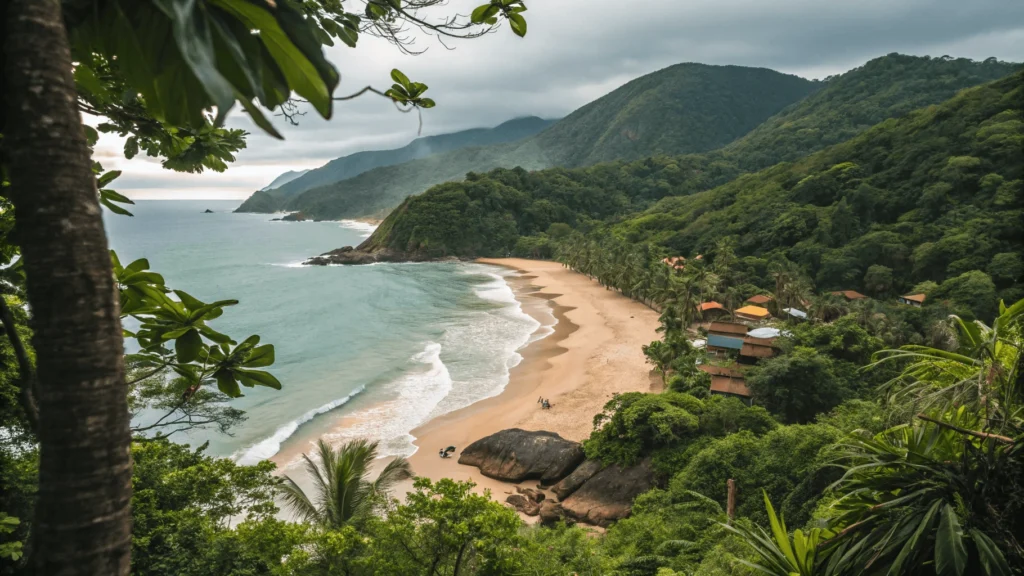
For travelers seeking tranquility away from crowds, these lesser-known beaches in brazil offer pristine environments and peaceful experiences. “beaches in brazil”
Praia do Espelho (Bahia)
- Accessibility: Moderate difficulty via unpaved roads
- Accommodations: Limited boutique options
- Unique Feature: Mirror-like natural pools at low tide
Praia de Lopes Mendes (Ilha Grande, Rio de Janeiro State)
- Accessibility: Requires boat ride plus hiking trail
- Accommodations: None on beach (stay in Vila do Abraão)
- Unique Feature: 3 km of perfectly preserved, powdery white sand
Praia do Bonete (Ilhabela, São Paulo)
- Accessibility: Challenging 3-hour hike or boat ride
- Accommodations: Simple local pousadas and homestays
- Unique Feature: Traditional caiçara fishing community
Praia do Aventureiro (Ilha Grande, Rio de Janeiro State)
- Accessibility: Limited permits required, boat access only
- Accommodations: Camping or local family stays
- Unique Feature: Bent coconut palm perfect for photos
Barra do Cahy (Bahia)
- Accessibility: Remote location with limited road access
- Accommodations: Very limited, mainly in nearby communities
- Unique Feature: Historically significant as the first landing site of the Portuguese in Brazil
Prainha do Canto (Lagoa do Paraíso, Ceará)
- Accessibility: 4×4 vehicles or organized tours
- Accommodations: Limited options in Jericoacoara
- Unique Feature: Hammocks suspended in calm blue waters
Praia Brava (Cabo Frio, Rio de Janeiro State)
- Accessibility: Hiking trail from Praia do Peró
- Accommodations: None on beach
- Unique Feature: Untouched shoreline with dramatic dunes
Praia de Leça (Ilha do Mel, Paraná)
- Accessibility: Boat to island, then trail access
- Accommodations: Simple pousadas in main village
- Unique Feature: Pristine environment within ecological station
Best beaches in brazil for Snorkeling/Diving
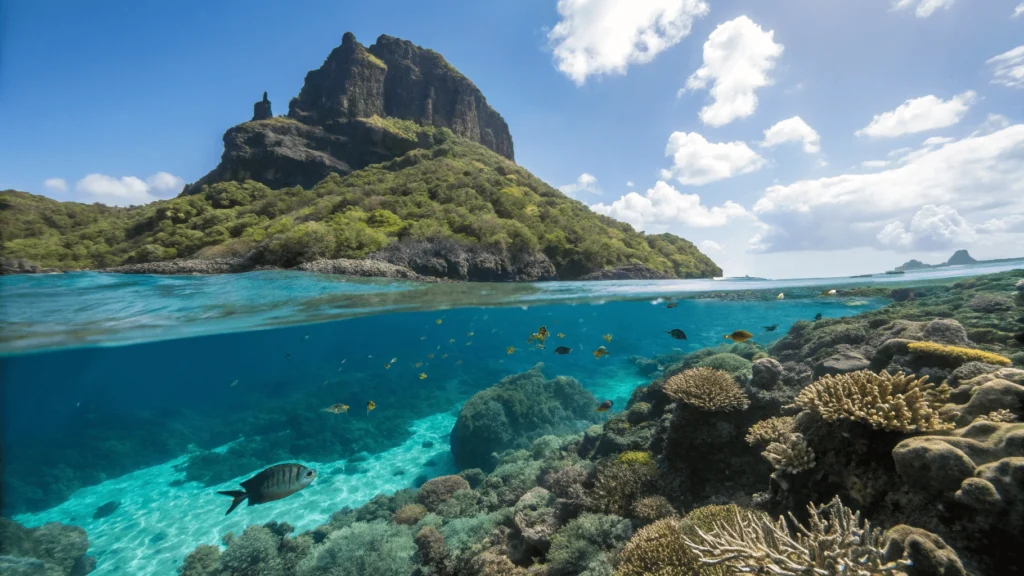
Brazil’s diverse marine ecosystems offer excellent opportunities for underwater exploration. “beaches in brazil”
Praia do Porto (Fernando de Noronha)
- Marine Life: Sea turtles, rays, reef fish, occasional sharks
- Water Conditions: Clear visibility (up to 50m), warm waters
- Facilities: Diving operators, equipment rental
- Best Season: September-March for calmest seas
Praia de Maracajaú (Rio Grande do Norte)
- Marine Life: Coral formations, colorful fish, sea urchins
- Water Conditions: Natural reef aquarium, protected area
- Facilities: Organized boat trips, equipment rental
- Best Season: Year-round, tide-dependent
Recife de Fora (Porto Seguro, Bahia)
- Marine Life: Extensive coral reef system, tropical fish
- Water Conditions: Accessible reef exposed at low tide
- Facilities: Guided tours, environmental education
- Best Season: Year-round during low tide periods
Parcel das Paredes (Abrolhos, Bahia)
- Marine Life: Brazil’s largest coral reef system, whales (seasonal)
- Water Conditions: Varied dive sites for different levels
- Facilities: Liveaboard trips, full diving services
- Best Season: Year-round for corals, July-November for whales
Praia dos Carneiros (Pernambuco)
- Marine Life: Reef fish, small corals, crustaceans
- Water Conditions: Calm, clear waters in natural pools
- Facilities: Snorkel equipment rental, guided tours
- Best Season: Year-round, best at low tide
Taipus de Fora (Península de Maraú, Bahia)
- Marine Life: Diverse reef ecosystem in natural pools
- Water Conditions: Crystal clear natural aquariums
- Facilities: Basic equipment rental, some guided options
- Best Season: Year-round, tide-dependent
Praia da Barra (Bombinhas, Santa Catarina)
- Marine Life: Southern species, diverse underwater landscape
- Water Conditions: Protected bay with good visibility
- Facilities: Multiple dive operators, courses available
- Best Season: December-March for warmest waters
Ilha do Arvoredo Marine Reserve (Santa Catarina)
- Marine Life: Protected species, unique southern Atlantic ecosystem
- Water Conditions: Cooler waters, some currents
- Facilities: Licensed dive operators from Florianópolis
- Best Season: December-April for best visibility
Most Beautiful/Scenic beaches in brazil
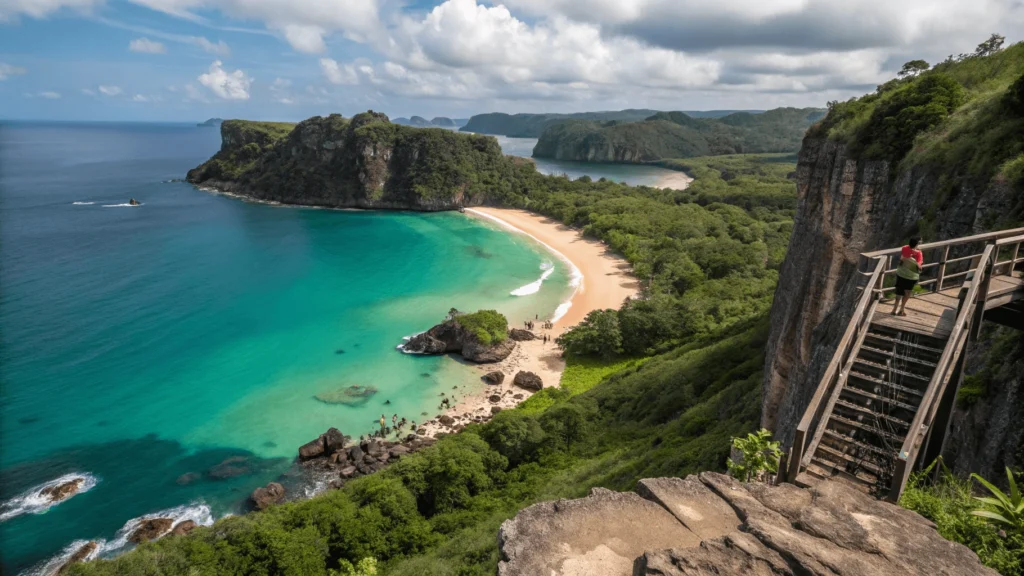
These beaches in brazil stand out for their extraordinary natural beauty, dramatic landscapes, and photogenic qualities. “beaches in brazil”
Baía do Sancho (Fernando de Noronha)
- Landscape Features: Dramatic cliffs, crystal waters, lush vegetation
- Viewing Points: Clifftop viewpoint before descending to beach
- Best Photography Time: Morning for ideal lighting
- Unique Visual Element: Contrast between emerald waters and rock formations
Praia de Dois Rios (Ilha Grande, Rio de Janeiro State)
- Landscape Features: Two rivers meeting the ocean

